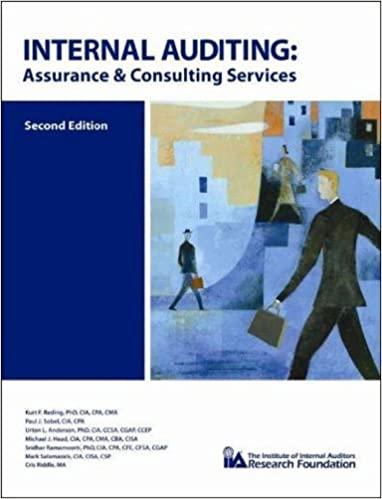Question
Merchandise company A merchandise companys sales and purchases during the year are as follows. Date Transaction Quantity Cost/unit Price/unit Collection Jan 1 Beg. Inv. 100
Merchandise company
A merchandise companys sales and purchases during the year are as follows.
| Date | Transaction | Quantity | Cost/unit | Price/unit | Collection |
| Jan 1 | Beg. Inv. | 100 |
|
|
|
| Jan 12 | Purchase | 60 | 16 |
|
|
| Jan 29 | Purchase | 80 | 17 |
|
|
| Feb 26 | Sale | 70 |
| 24 | Cash sale |
| Mar 15 | Sale | 50 |
| 25 | Apr 28 |
| Apr 26 | Purchase | 40 | 19 |
|
|
| May 6 | Sale | 50 |
| 25 | Jul 17 |
| May 14 | Sale | 30 |
| 27 | Uncollected |
| Jun 3 | Purchase | 40 | 20 |
|
|
| Jul 6 | Sale | 30 |
| 26 | Jul 8 |
| Aug 20 | Purchase | 20 | 20 |
|
|
| Sep 5 | Purchase | 30 | 21 |
|
|
| Oct 19 | Sale | 60 |
| 29 | Uncollected |
| Dec 4 | Sale | 40 |
| 30 | Uncollected |
| Dec 15 | Purchase | 60 | 22 |
|
|
| Dec 31 | End. Inv. | 100 |
|
|
|
Cost per unit of beginning inventory for each method is as follows.
|
| Perpetual | Periodic |
| FIFO | 15 | 15 |
| LIFO | 13 | 10 |
| Weighted Average | 14 | 12 |
The sales price per unit above is the undiscounted price. The company discounts 3% from cash sales and offers 2/30, n/90 as the term of credit sales.
The company had $500 of allowance for doubtful accounts at the end of the previous year. The company wrote off $100 of accounts receivable from the previous year but did not write off any accounts receivable from the current year. All other accounts receivable from the previous year were collected during the current year.
Answer the following questions using the above facts.
(a) What is the companys net sales (do not consider bad debt expense here)?
(b) Suppose the company uses the percentage-of-sales method to determine bad debt expense. If the company uses 3% of undiscounted credit sales as an estimate of bad debt expense, what are bad debt expense and ending balance of allowance for doubtful accounts?
(c) Suppose the company uses the aging-of-accounts method to determine bad debt expense. If the company estimates 1% of accounts receivable aged 0-30 days uncollectible, 5% of accounts receivable aged 31-90 days uncollectible, 25% of accounts receivable aged 91-180 days uncollectible, and 70% of accounts receivable aged more than 181 days uncollectible, what are bad debt expense and ending balance of allowance for doubtful accounts?
(d) Just for this question, suppose the company wrote off accounts receivable from sales on May 14. How would your answers to (b) change? Do you think the company can still use 3% to estimate bad debt expense? Does the company have a similar issue if it used the aging-of-accounts method?
(e) Just for this question, suppose the company had $1,000 of allowance for doubtful accounts at the end of the previous year. Does the manager have any discretion to manipulate net income just by deciding which accounts receivable should be written off (without adjusting the percentages)? Support your answer by showing how your answers to (b) and (c) change when the company writes off accounts receivable from sales on May 14.
(f) Suppose the company uses the periodic method to track inventory. For the three inventory flow assumptions, what are cost of goods sold and ending balance of inventory? How much is the LIFO reserve?
(g) Suppose the company uses the perpetual method to track inventory. For the three inventory flow assumptions, what are cost of goods sold for each sales transaction? What are cost of goods sold for the whole year and ending balance of inventory? How much is the LIFO reserve?
(h) Using your answers in (f) and (g), show that LIFO cost of goods sold is larger than FIFO cost of goods sold by the amount of LIFO reserve increase during the year.
(i) Suppose the company has an option to return the purchase on December 15 before year end. Which combinations of inventory tracking method and inventory flow assumption allows the manager to manipulate net income using this option? What are the new cost of goods sold for such combinations assuming that the option is exercised? If the manager wants to increase net income, would he/she exercise the option?
(j) Just for this question, suppose the net realizable value of the inventory dropped to $20 per unit due to a demand shock around Christmas. How much loss should the company recognize for each combination of inventory tracking method and inventory flow assumption?
Step by Step Solution
There are 3 Steps involved in it
Step: 1

Get Instant Access to Expert-Tailored Solutions
See step-by-step solutions with expert insights and AI powered tools for academic success
Step: 2

Step: 3

Ace Your Homework with AI
Get the answers you need in no time with our AI-driven, step-by-step assistance
Get Started


